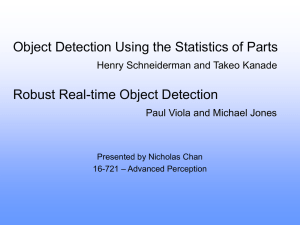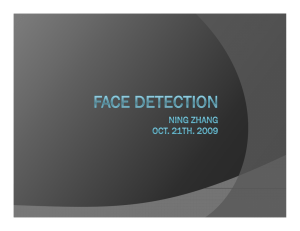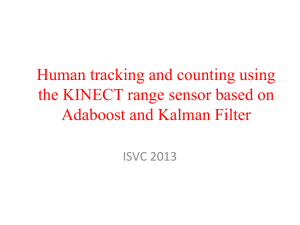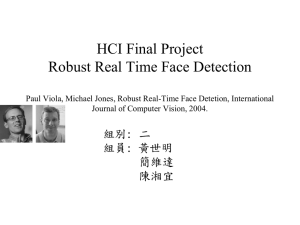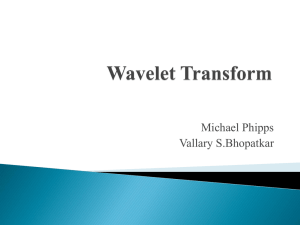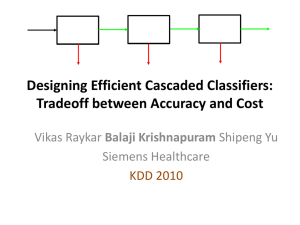Lecture 18 - Sliding Window Detection
advertisement
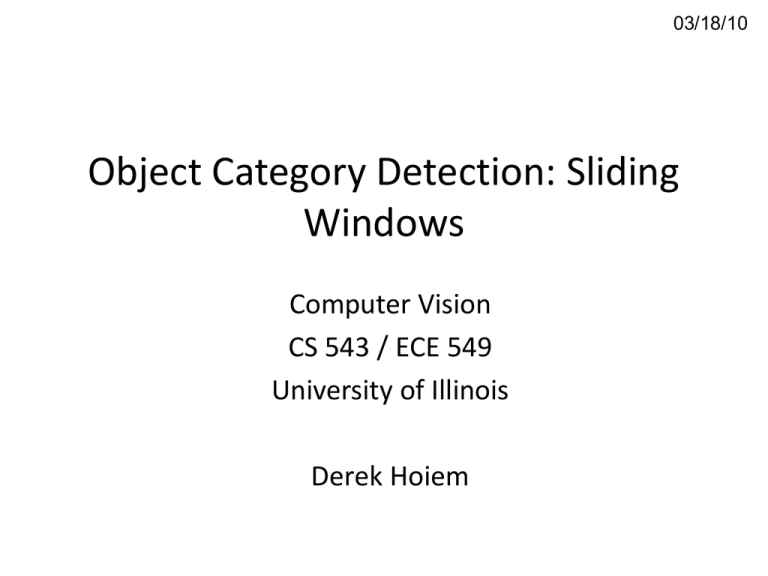
03/18/10 Object Category Detection: Sliding Windows Computer Vision CS 543 / ECE 549 University of Illinois Derek Hoiem Goal: Detect all instances of objects Influential Works in Detection • Sung-Poggio (1994, 1998) : ~1450 citations – Basic idea of statistical template detection (I think), bootstrapping to get “face-like” negative examples, multiple whole-face prototypes (in 1994) • Rowley-Baluja-Kanade (1996-1998) : ~2900 – “Parts” at fixed position, non-maxima suppression, simple cascade, rotation, pretty good accuracy, fast • Schneiderman-Kanade (1998-2000,2004) : ~1250 – Careful feature engineering, excellent results, cascade • Viola-Jones (2001, 2004) : ~6500 – Haar-like features, Adaboost as feature selection, hyper-cascade, very fast, easy to implement • Dalal-Triggs (2005) : 1025 – Careful feature engineering, excellent results, HOG feature, online code • Felzenszwalb-McAllester-Ramanan (2008)? 105 citations – Excellent template/parts-based blend Sliding window detection What the Detector Sees Statistical Template • Object model = log linear model of parts at fixed positions ? +3 +2 -2 -1 -2.5 = -0.5 > 7.5 Non-object ? +4 +1 +0.5 +3 +0.5 = 10.5 > 7.5 Object Design challenges • Part design – How to model appearance – Which “parts” to include – How to set part likelihoods • How to make it fast • How to deal with different viewpoints • Implementation details – – – – Window size Aspect ratio Translation/scale step size Non-maxima suppression Schneiderman and Kanade Schneiderman and Kanade. A Statistical Method for 3D Object Detection. (2000) Schneiderman and Kanade Decision function: Parts model • Part = group of wavelet coefficients that are statistically dependent Parts: groups of wavelet coefficients • Fixed parts within/across subbands • 17 types of “parts” that can appear at each position • Discretize wavelet coefficient to 3 values • E.g., part with 8 coefficients has 3^8 = 6561 values Part Likelihood • Class-conditional likelihood ratio • Estimate P(part|object) and P(part | nonobject) by counting over examples count( part & object) P( part | object) count(object) • Adaboost tunes weights discriminatively Training 1) Create training data a) Get positive and negative patches b) Pre-process (optional), compute wavelet coefficients, discretize c) Compute parts values 2) Learn statistics a) Compute ratios of histograms by counting for positive and negative examples b) Reweight examples using Adaboost, recount, etc. 3) Get more negative examples (bootstrapping) Training multiple viewpoints Train new detector for each viewpoint. Testing 1) Processing: a) Lighting correction (optional) b) Compute wavelet coefficients, quantize 2) Slide window over each position/scale (2 pixels, 21/4 scale) a) b) c) d) Compute part values Lookup likelihood ratios Sum over parts Threshold 3) Use faster classifier to prune patches (cascade…more on this later) 4) Non-maximum suppression Results: faces 208 images with 441 faces, 347 in profile Results: cars Results: faces today http://demo.pittpatt.com/ Viola and Jones Fast detection through two mechanisms Viola and Jones. Rapid Object Detection using a Boosted Cascade of Simple Features (2001). Integral Images • “Haar-like features” – Differences of sums of intensity – Thousands, computed at various positions and scales within detection window -1 +1 Two-rectangle features Three-rectangle features Etc. Integral Images • ii = cumsum(cumsum(Im, 1), 2) x, y ii(x,y) = Sum of the values in the grey region How to compute B-A? How to compute A+D-B-C? Adaboost as feature selection • Create a large pool of parts (180K) • “Weak learner” = feature + threshold + parity • Choose weak learner that minimizes error on the weighted training set • Reweight Adaboost Adaboost “RealBoost” Important special case: ht partitions input space: alphat Figure from Friedman et al. 1999 Adaboost: Immune to Overfitting? Test error Train error Interpretations of Adaboost • Additive logistic regression (Friedman et al. 2000) – LogitBoost from Collins et al. 2002 does this more explicitly • Margin maximization (Schapire et al. 1998) – Ratch and Warmuth 2002 do this more explicitly Adaboost: Margin Maximizer Test error Train error margin Cascade for Fast Detection Yes Stage 1 H1(x) > t1? No Yes Stage 2 H2(x) > t2? No … Stage N HN(x) > tN? No Examples Reject Reject Reject • Choose threshold for low false negative rate • Fast classifiers early in cascade • Slow classifiers later, but most examples don’t get there Pass Viola-Jones details • 38 stages with 1, 10, 25, 50 … features – 6061 total used out of 180K candidates – 10 features evaluated on average • Examples – 4916 positive examples – 10000 negative examples collected after each stage • Scanning – Scale detector rather than image – Scale steps = 1.25, Translation 1.0*s to 1.5*s • Non-max suppression: average coordinates of overlapping boxes • Train 3 classifiers and take vote Viola Jones Results MIT + CMU face dataset Schneiderman later results Schneiderman 2004 Viola-Jones 2001 Roth et al. 1999 SchneidermanKanade 2000 Speed: frontal face detector • Schneiderman-Kanade (2000): 5 seconds • Viola-Jones (2001): 15 fps Occlusions? • A problem • Objects occluded by > 50% considered “don’t care” • PASCAL VOC changed this Strengths and Weaknesses of Statistical Template Approach Strengths • Works very well for non-deformable objects: faces, cars, upright pedestrians • Fast detection Weaknesses • Not so well for highly deformable objects • Not robust to occlusion • Requires lots of training data SK vs. VJ Schneiderman-Kanade Viola-Jones • Wavelet features • Log linear model via boosted histogram ratios • Bootstrap training • Two-stage cascade • Similar to Haar wavelets • Log linear model via boosted stubs • Bootstrap training • Multistage cascade, integrated into training • NMS: average coordinates of overlapping boxes • Less accurate but very fast • NMS: Remove overlapping weak boxes • Slow but very accurate Things to remember • Excellent results require careful feature engineering • Sliding window for search • Features based on differences of intensity (gradient, wavelet, etc.) • Boosting for feature selection (also L1-logistic regression) Yes Stage 1 H1(x) > t1? • Integral images, cascade for speed Stage 2 H2(x) > t2? No … • Bootstrapping to deal with many, many negative examples Reject Pass No No Examples Reject Yes Stage N HN(x) > tN? Reject
